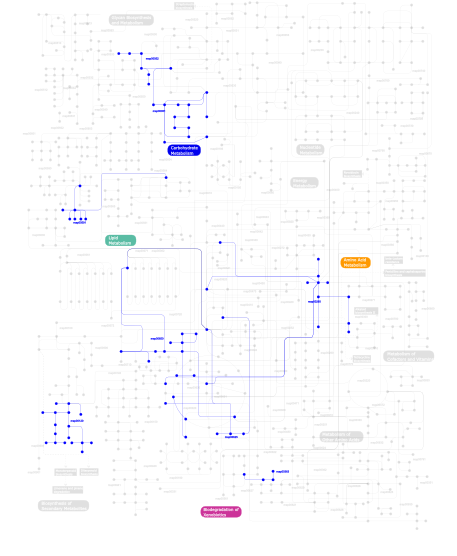The domain within your query sequence starts at position 3052 and ends at position 3092; the E-value for the LY domain shown below is 3.22e-9.
SVVIETKISRPMALTIDYVNHRLYWADENHIEFSNMDGSHR
LYLow-density lipoprotein-receptor YWTD domain |
|---|
| SMART accession number: | SM00135 |
|---|---|
| Description: | Type "B" repeats in low-density lipoprotein (LDL) receptor that plays a central role in mammalian cholesterol metabolism. Also present in a variety of molecules similar to gp300/megalin. |
| Interpro abstract (IPR000033): | This entry represents the LDLR classB (YWTD) repeat, the structure of which has been solved [ (PUBMED:11373616) ]. The six YWTD repeats together fold into a six-bladed beta-propeller. Each blade of the propeller consists of four antiparallel beta-strands; the innermost strand of each blade is labeled 1 and the outermost strand, 4. The sequence repeats are offset with respect to the blades of the propeller, such that any given 40-residue YWTD repeat spans strands 24 of one propeller blade and strand 1 of the subsequent blade. This offset ensures circularization of the propeller because the last strand of the final sequence repeat acts as an innermost strand 1 of the blade that harbors strands 24 from the first sequence repeat. The repeat is found in a variety of proteins that include, vitellogenin receptor from Drosophila melanogaster, low-density lipoprotein (LDL) receptor [ (PUBMED:6091915) ], preproepidermal growth factor, and nidogen (entactin). The low-density lipoprotein receptor (LDLR) is the major cholesterol-carrying lipoprotein of plasma, acting to regulate cholesterol homeostasis in mammalian cells. The LDL receptor binds LDL and transports it into cells by acidic endocytosis. In order to be internalized, the receptor-ligand complex must first cluster into clathrin-coated pits. Once inside the cell, the LDLR separates from its ligand, which is degraded in the lysosomes, while the receptor returns to the cell surface [ (PUBMED:3513311) ]. The internal dissociation of the LDLR with its ligand is mediated by proton pumps within the walls of the endosome that lower the pH. The LDLR is a multi-domain protein, containing:
LDLR is closely related in structure to several other receptors, including LRP1, LRP1b, megalin/LRP2, VLDL receptor, lipoprotein receptor, MEGF7/LRP4, and LRP8/apolipoprotein E receptor2); these proteins participate in a wide range of physiological processes, including the regulation of lipid metabolism, protection against atherosclerosis, neurodevelopment, and transport of nutrients and vitamins [ (PUBMED:17457719) ]. |
| Family alignment: |
There are 128751 LY domains in 13670 proteins in SMART's nrdb database.
Click on the following links for more information.
- Evolution (species in which this domain is found)
- Literature (relevant references for this domain)
- Disease (disease genes where sequence variants are found in this domain)
- Metabolism (metabolic pathways involving proteins which contain this domain)
- Structure (3D structures containing this domain)
- Links (links to other resources describing this domain)


























